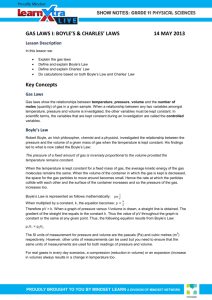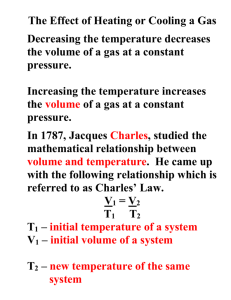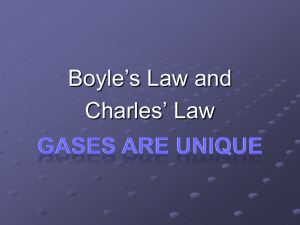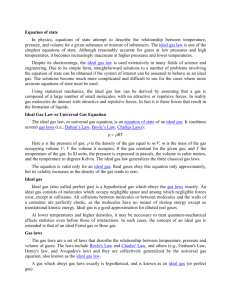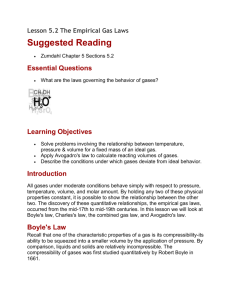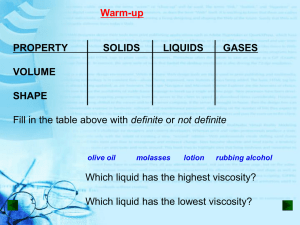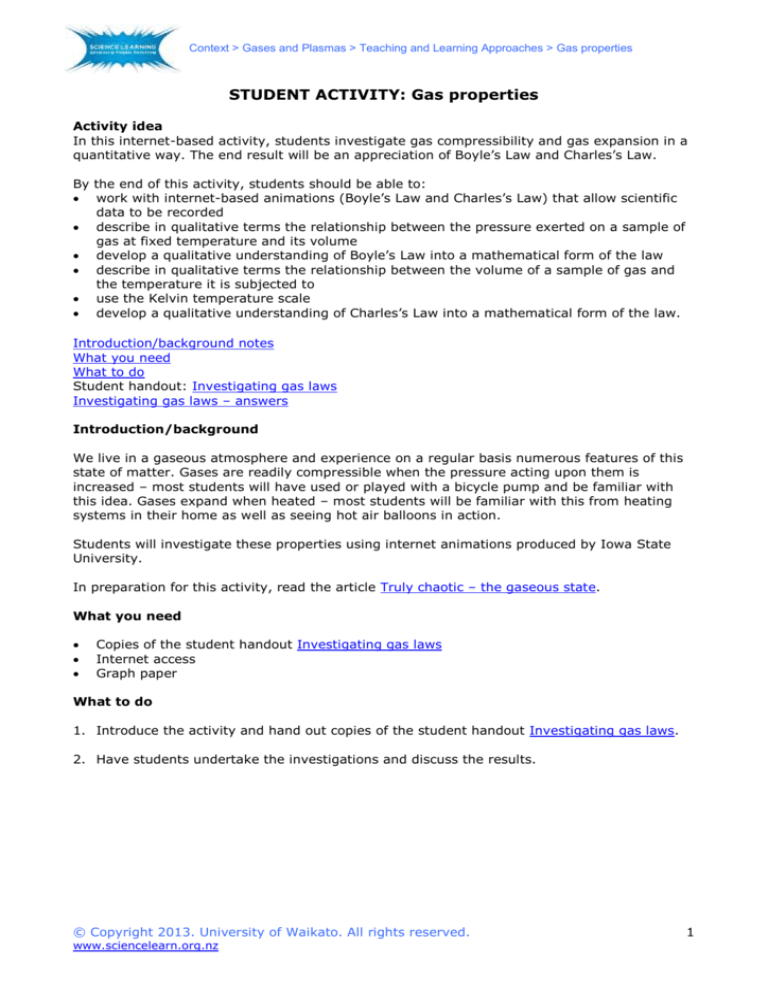
Context > Gases and Plasmas > Teaching and Learning Approaches > Gas properties
STUDENT ACTIVITY: Gas properties
Activity idea
In this internet-based activity, students investigate gas compressibility and gas expansion in a
quantitative way. The end result will be an appreciation of Boyle’s Law and Charles’s Law.
By the end of this activity, students should be able to:
work with internet-based animations (Boyle’s Law and Charles’s Law) that allow scientific
data to be recorded
describe in qualitative terms the relationship between the pressure exerted on a sample of
gas at fixed temperature and its volume
develop a qualitative understanding of Boyle’s Law into a mathematical form of the law
describe in qualitative terms the relationship between the volume of a sample of gas and
the temperature it is subjected to
use the Kelvin temperature scale
develop a qualitative understanding of Charles’s Law into a mathematical form of the law.
Introduction/background notes
What you need
What to do
Student handout: Investigating gas laws
Investigating gas laws – answers
Introduction/background
We live in a gaseous atmosphere and experience on a regular basis numerous features of this
state of matter. Gases are readily compressible when the pressure acting upon them is
increased – most students will have used or played with a bicycle pump and be familiar with
this idea. Gases expand when heated – most students will be familiar with this from heating
systems in their home as well as seeing hot air balloons in action.
Students will investigate these properties using internet animations produced by Iowa State
University.
In preparation for this activity, read the article Truly chaotic – the gaseous state.
What you need
Copies of the student handout Investigating gas laws
Internet access
Graph paper
What to do
1. Introduce the activity and hand out copies of the student handout Investigating gas laws.
2. Have students undertake the investigations and discuss the results.
© Copyright 2013. University of Waikato. All rights reserved.
www.sciencelearn.org.nz
1
Context > Gases and Plasmas > Teaching and Learning Approaches > Gas properties
Student handout: Investigating gas laws
Boyle’s Law
1. Access the interactive at
http://group.chem.iastate.edu/Greenbowe/sections/projectfolder/flashfiles/gaslaw/boyles_l
aw_graph.html
2. Use the mouse to drag the plunger to a selected volume. Note how the programme records
the volume and pressure values.
3. Complete the table below for air as the selected gas.
Volume (V)
mL
Pressure (P)
psi
Inverse of volume (1/V)
Pressure x volume (P x V)
4. Using graph paper, create a graph of pressure (P) versus volume (V) for the data you have
recorded. Be certain to label the axes of each graph and provide a scale for both axes on
each graph. Pressure should be recorded on the y-axis and volume on the x-axis.
5. Using a separate sheet of graph paper, create a graph of pressure (P) versus 1/V.
6. From the results table, how does the volume of a gas change as the pressure on it
increases?
7. What word is often used to describe this property of gases?
8. How do the values recorded in the P x V column for each trial compare?
9. Of the two graphs you have drawn, which one shows a straight-line relationship?
10. Can you write a mathematical relationship for the straight-line graph? (This relationship is
known as Boyle’s Law, in honour of Robert Boyle. Google this name to find out more about
his contribution to science.)
Charles’s Law
11. Access the interactive at
http://group.chem.iastate.edu/Greenbowe/sections/projectfolder/flashfiles/gaslaw/charles_
law.html
12. Move the slider so that the temperature reading is 123 K. This temperature on the absolute
or Kelvin temperature scale is the equivalent of -1500°C. (To convert 0°C into kelvin, add
273).
13. Press the ‘Show Data Table’ button. Progressively increase the temperature in 30 K
increments until 423 K (1500°C) is reached. Note what happens to the volume of the gas
in each case.
© Copyright 2013. University of Waikato. All rights reserved.
www.sciencelearn.org.nz
2
Context > Gases and Plasmas > Teaching and Learning Approaches > Gas properties
14. Complete the table below for. (Note that, in the data table, temperature is recorded in
kelvin not °C and volume in cm3.)
Volume (V)
cm3
Temperature (T)
K
Volume/temperature
V/T
15. Using graph paper, create a graph of volume (V) versus temperature (T) for the data you
have recorded. Be certain to label the axes of the graph and provide a scale for both axes.
Volume should be recorded on the y-axis and temperature on the x-axis.
16. From the results table, how does the volume of a gas change as the temperature of the gas
is increased?
17. How do the values recorded in the V/T column for each trial compare?
18. Does the graph you have drawn show a straight-line relationship?
19. To reduce the volume of the gas to 0, what temperature is needed?
20. Can you write a mathematical relationship linking the volume of a gas with its temperature
in kelvin units? (The relationship is known as Charles’s Law, in honour of Jacques Charles.
Google this name to find out more about his contribution to science and to hot air
ballooning.)
© Copyright 2013. University of Waikato. All rights reserved.
www.sciencelearn.org.nz
3
Context > Gases and Plasmas > Teaching and Learning Approaches > Gas properties
Investigating gas laws – answers
6. From the results table, how does the volume of a gas change as the pressure on it
increases?
The volume decreases.
7. What word is often used to describe this property of gases?
Gases are compressible.
8. How do the values recorded in the P x V column for each trial compare?
They are constant.
9. Of the two graphs you have drawn, which one shows a straight-line relationship?
P versus 1/V graph is a straight line.
10. Can you write a mathematical relationship for the straight-line graph? (This relationship is
known as Boyle’s Law, in honour of Robert Boyle. Google this name to find out more about
his contribution to science.)
P is directly proportional to 1/V. Provided the pressure and volume units remain the same,
this becomes P1V1=P2V2, which is the Boyle’s Law formula.
16. From the results table, how does the volume of a gas change as the temperature of the
gas is increased?
As the temperature of the gas increases so does its volume.
17. How do the values recorded in the V/T column for each trial compare?
They are constant.
18. Does the graph you have drawn show a straight-line relationship?
Yes.
19. To reduce the volume of the gas to 0, what temperature is needed?
The temperature needed is 0 K or -273°C.
20. Can you write a mathematical relationship linking the volume of a gas with its temperature
in kelvin units? (The relationship is known as Charles’s Law, in honour of Jacques Charles.
Google this name to find out more about his contribution to science and to hot air
ballooning.)
V is directly proportional to T. Provided the temperature is measured in kelvin and the
volume units remain the same, this becomes V1/T1=V2/T2, which is the Charles’s Law
formula.
© Copyright 2013. University of Waikato. All rights reserved.
www.sciencelearn.org.nz
4


